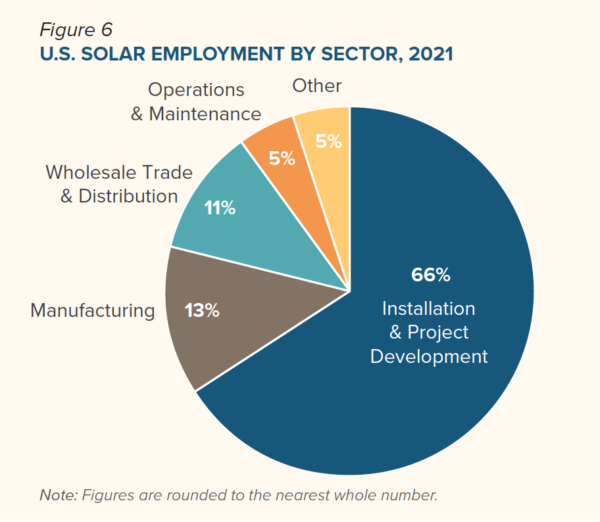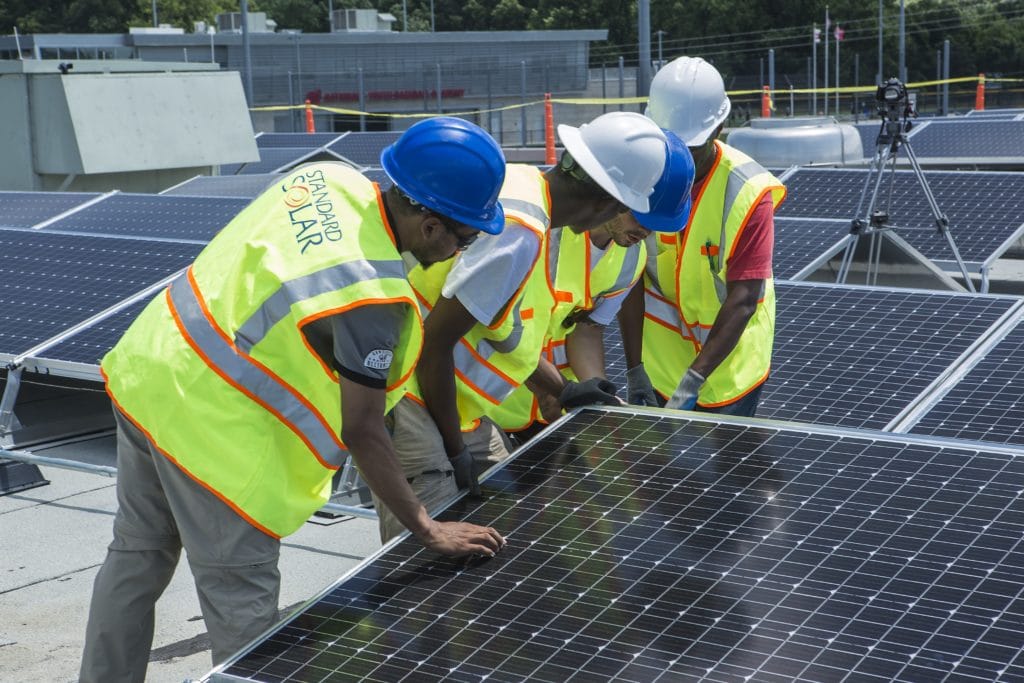Solar energy jobs were up in 47 states and increased 9% nationwide from 2020 to 2021 to a total of 255,037 solar workers, according to the annual National Solar Jobs Census released today by the Interstate Renewable Energy Council (IREC), an independent national nonprofit organization.
This job growth follows 2020, which was a tough year for many industries. The US solar industry employed 231,474 workers in 2020, a 6.7% drop from 2019 due to pandemic restrictions and increased labor productivity, according to the National Solar Jobs Census 2020. The job growth in 2021 reflects a rebound taking place in what was a record year for solar installations. Overall, the solar industry added 21,563 jobs in 2021, with more than two-thirds of these new jobs (14,350) at installation and project development firms.
“America’s solar industry came back strong from the pandemic to expand the clean energy workforce across all regions of the country,” said Larry Sherwood, president and CEO at IREC. “The future remains uncertain in light of the supply chain disruptions, trade issues, and stalled federal policy in the first part of 2022. There is potential for unprecedented job growth in the coming years if federal, state, and local leaders take action to expand clean energy use and address climate change.”
The National Solar Jobs Census was first published in 2010 by The Solar Foundation, which merged with IREC in 2021. It’s interesting to look over the past decade with US solar employment more than doubling from 105,145 jobs in 2011 to 255,037 jobs in 2021. The most significant growth has taken place in the installation and project development sector, where employment more than tripled since 2011 to reach 168,960 jobs in 2021.
State by state
Not surprisingly, California—the number one solar market in the country—was way ahead of other states in solar employment with 75,712 jobs as of 2021. Florida, the Sunshine State and number three solar market in the country, came in second with 11,761 jobs, Massachusetts, ninth for solar installations had 10,548 solar jobs. New York followed closely with 10,524 jobs and Texas at 10,346 jobs. Arizona, Colorado, Nevada, and Ohio, each had between 7,000 to 9,000 jobs.
California also led for the number of jobs added (+7,035) in 2021, followed by Massachusetts (+1,053 jobs), Nevada (+1,019 jobs), and Arizona (+932 jobs). Other strong growth states were Ohio, North Carolina, New Jersey, and Georgia, each with 800 to 900 new jobs. A complete table of solar jobs by state and job growth from 2020 is available here.
“Solar energy is an economic growth engine, creating new jobs while it helps us confront the climate crisis,” said Dan Reicher, Senior Scholar, Stanford Woods Institute and former US Assistant Secretary of Energy. “There is vast and untapped potential to expand solar installations and related jobs across the United States, in an environmentally sustainable manner, as we help businesses and families access this renewable energy source.”
Diversity
The solar industry has more work to do to meet its goals for diversity, equity, and inclusion. The report found that women made up just under 30 % of the solar workforce in 2021, which held steady from 2020. This is a surprisingly low figure when compared to the fact that women make up 47% of of the overall workforce in the United States. Unfortunately, only 31% of solar firms reported that they have strategies, policies or programs to increase the number of women hired.
To help women join the solar workforce, Solar Energy International (SEI) and SOLV Energy recently announced a partnership aimed at creating a global network of women who are considering careers in clean energy and supporting female solar professionals actively working in the industry. The SEI Women in Solar program consists of training, networking, mentorship, and clean energy employer and job connections, all with the goal of empowering women to join the clean energy sector and advance the careers and influence of women already working in the sector.
Black employees made up 8% of the solar workforce, compared to their 12% representation in the national workforce. Latino or Hispanic workers made up 20%, and Asian workers made up 9%. Fewer than one-third (26%) of solar firms reported strategies to increase female, ethnic or racial minority hires. Only 8% had a strategy to increase LGBTQ+ hires.
Puerto Rico job potential
The report looked at Puerto Rico, where solar has made strong inroads five years after hurricanes ravaged the island. While the island had just under 2,000 solar jobs in 2021, largely unchanged from 2019, that may change because a new law requires that Puerto Rico to obtain 40% of its electricity from renewables by 2025 and 100% by 2050. According to IREC’s research, meeting these goals would lead to 20,000 solar jobs in Puerto Rico by 2030.
Educational requirements and training
The solar industry can offer a path to advancement and job training. Less than one-third of entry-level solar jobs in the solar industry (31%) require a bachelor’s degree, while 65% of firms provide on-the-job training. In a year with a tight labor market, 89% of firms reported difficulty finding qualified applicants, with 35% saying it was “very difficult.”
Looking at solar jobs by employment sector shows that 66% of jobs were in installation and project development. 13% were in manufacturing, 11% in wholesale trade and distribution, with 5% in O&M (and another 5% in “other”). Looking at jobs by industry sector, 51% were in residential, 20% in commercial, 20% in utility scale, and 9% in community solar.

“These 2021 findings highlight that we can create family-sustaining jobs at the same time that we reduce carbon emissions,” said Tom Starrs, Vice President, Government and Public Affairs at EDP Renewables. “They also highlight the critical importance of supportive policies to unlock the full potential of the solar industry to drive employment, foster local energy resilience, and confront climate change.”
Better than fossils
Employment in the solar industry looks favorable compared to the fossil fuel industry. Solar employs over twice as many as the coal industry. And while the petroleum and natural gas industries employ more workers than solar, solar workers are needed to develop the infrastructure and not to generate the fuel itself. As a result, the solar industry employs more workers per unit of generation compared to fossil fuel sources.
This report analyzes data from the US Department of Energy’s US Energy and Employment Report 2022 and a supplemental follow-up survey of solar establishments. The full report and related data can be downloaded here.
This content is protected by copyright and may not be reused. If you want to cooperate with us and would like to reuse some of our content, please contact: editors@pv-magazine.com.









With utility priced electricity 3 times higher in California, it is no wonder that more lower cost solar energy is being installed in California. With electricity pushing 40 cents per kilo watt hour in California, rooftop solar is going gangbusters as special financing is made affordable and the Federal Tax credit pays you up front the first year. As battery systems come down in price, their adoption will increase substantially.